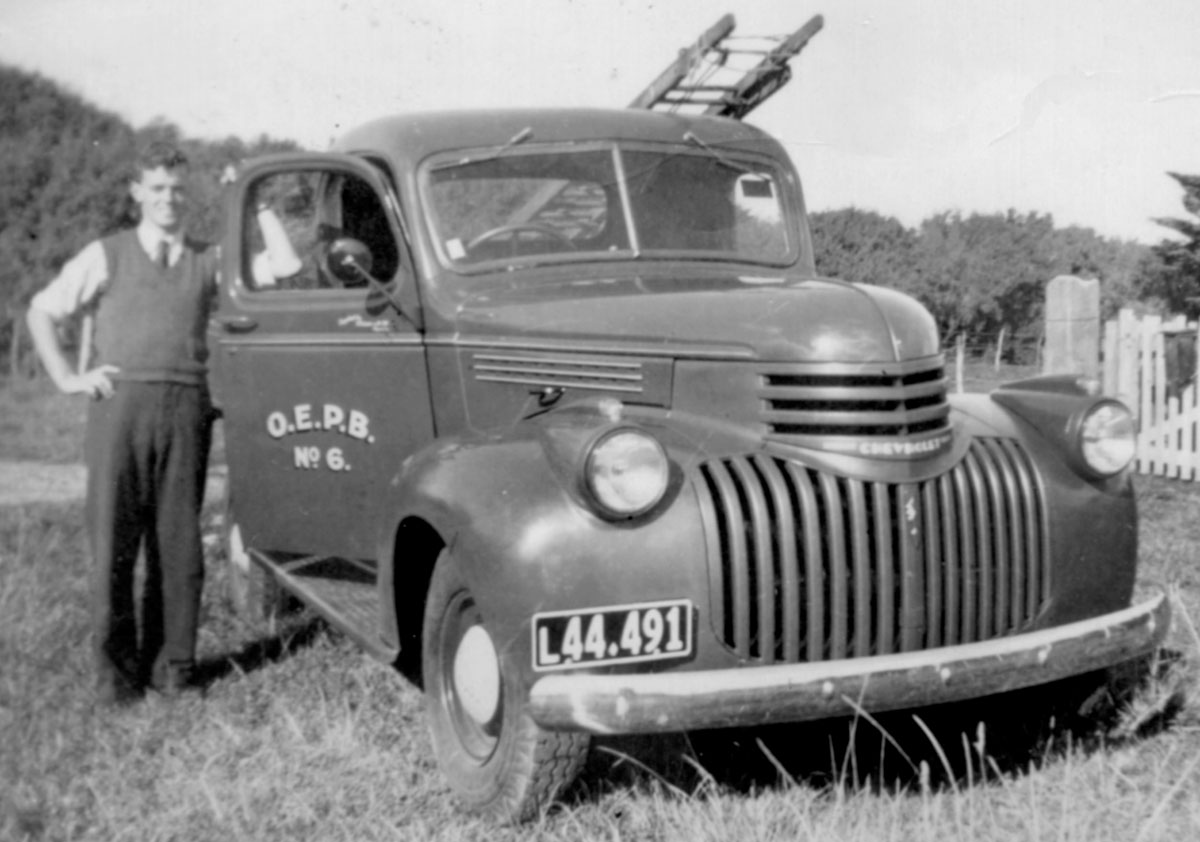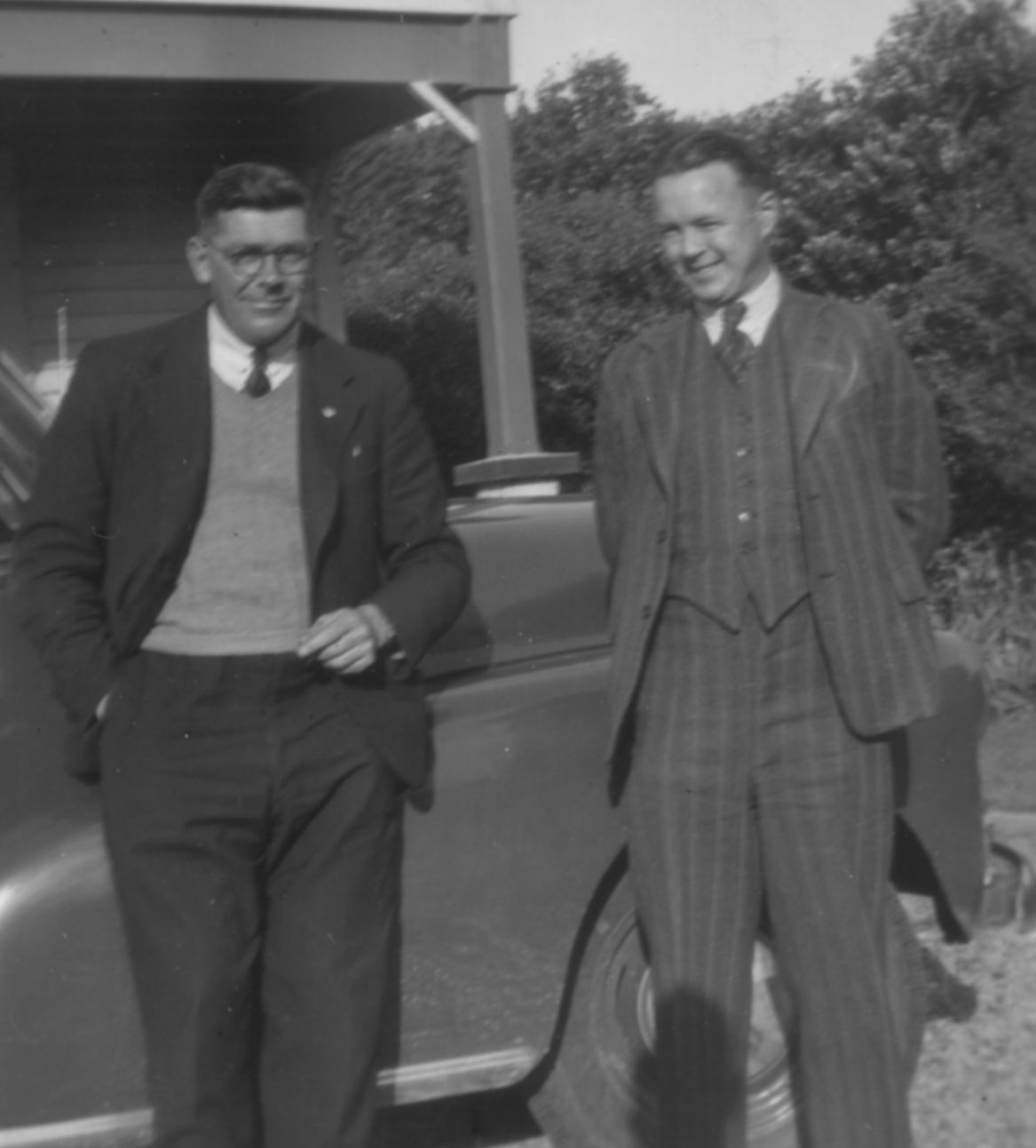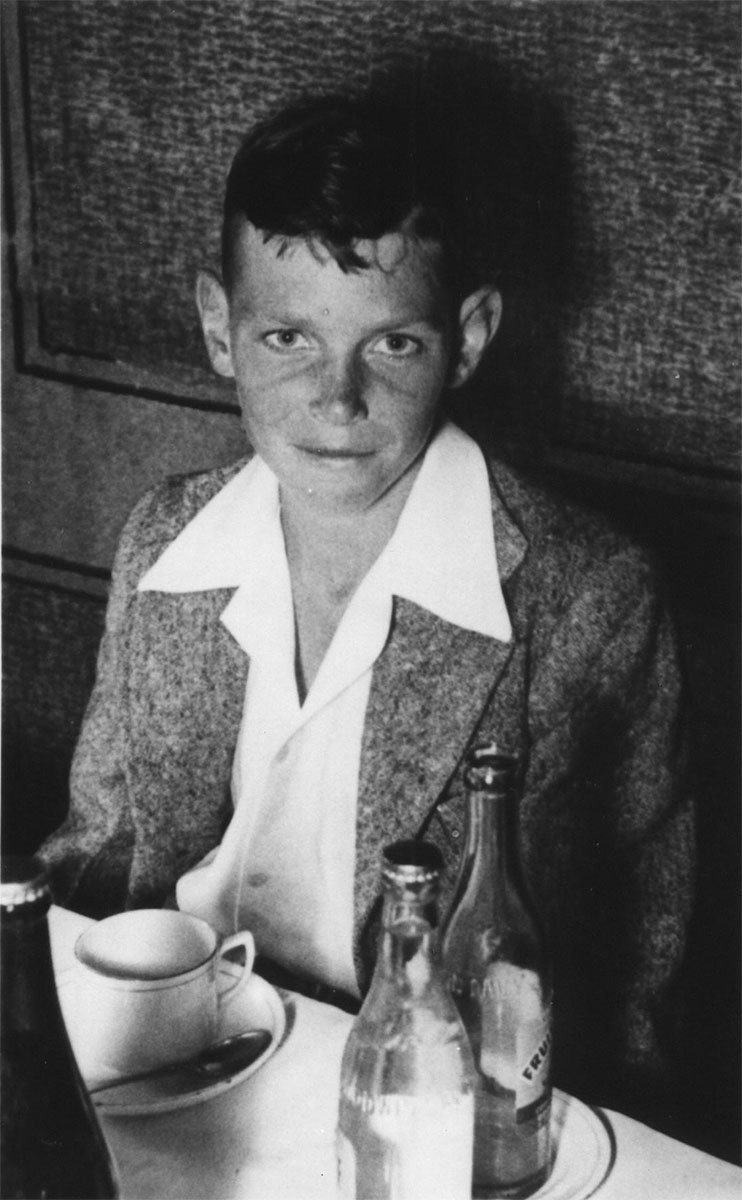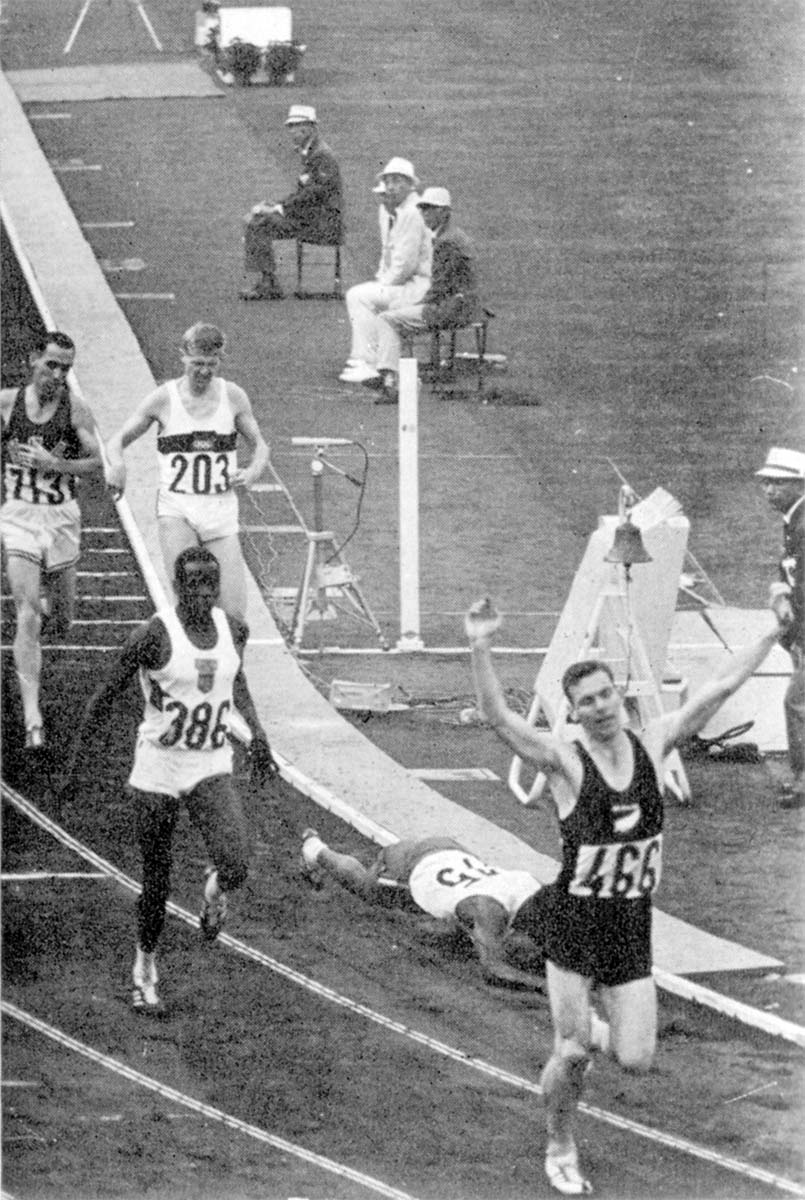







For 60 years, former Opunake man Gordon Keats has held a national secret close to his heart. This is his written confession: "The year was 1944. World War II was still raging and I was in my fourth year as an apprentice to the Opunake Electric Power Board. My boss, the engineer, had recently purchased a new Ford truck and it was time for its first service" Gordon writes. "I left the workshop at 3.30pm and headed for the garage. After making a right-hand turn from the main street I immediately recognised a young cyclist going in the same direction.
"It was my boss's youngest son, Peter, aged six. As I drew level, I gave a friendly toot on the horn. He looked to his right from his mini two-wheeler bike, wobbled, hit the side of the truck and collapsed on the side of the road," says Gordon, who now lives in Tauranga.
"I applied the brake, ran around the truck, carefully picked him up and placed him in the cab. Then I lifted his bicycle on to the tray of the Ford, drove to Peter's home, carried him in to his mother and then returned to work.
"Later that day, Peter's mother and father took him to New Plymouth hospital for an X-ray and medical check. Meanwhile, I had a restless night!
"Next day brought good news. Peter was fine - except for a few bruises. He was soon back on his bike and suffered no after effects. How can I be sure? He is now 65 years of age and has been one of the world's most famous athletes. His surname is Snell," Gordon ends.
Peter Snell went on to win gold medals in the 800 metres at the 1960 Rome Olympics, and the 1500 metres and 800 metres at the 1964 Tokyo Olympics. He also broke a handful of world records.
The Opunake-born athlete also broke bones, doing more damage to his body than Gordon Keats ever did. In a letter to his father's former apprentice, Peter wrote: "I unfortunately must confess that falling off the bike into the truck you were driving was the first of many injuries due to my carelessness on a bike. I have fractured collar bones on both sides and [have] a shoulder separation to remind me." These injuries happened much later in Peter's life - many years after he left Opunake and beyond his top-of-the-world athletic feats.
Despite the decades that have since passed, Peter has never forgotten his roots. In the United States, the picture on his computer desktop is of Mount Taranaki. The photo is dear to Peter, even though the mountain's geography doesn't equate with the picture in his mind. "It's from the Stratford (or Hāwera) side, so it's looking directly at Fanthams Peak and it looks like it's more pure as a cone," he says. "But from Opunake, Fanthams Peak sticks out on the right and that's the side that I'm familiar with. One day I'm going to get that picture."
For this interview, Peter is relaxing on a couch in an Auckland hotel during a week-long visit to New Zealand. His home these days is Dallas, where he is an associate professor at the University of Texas Southwestern Medical Centre.
For the first decade of his life, Peter lived in Opunake, where the view of the mountain (when not cloaked by cloud) is as dominant as the westerly winds that whip the coastal Taranaki town.
Peter George Snell was born in the Opunake Cottage Hospital on December 17, 1938. His mother, Margaret, was assisted in bringing her youngest child into the world by district nurse and midwife Merica Wehipeihana.
These days, the maternity home is caring for people at the other end of their lives. Peter is quick to say he doesn't intend to spend his twilight years in The Cottage Rest Home - or any other institution for the aged. "I'm not going to be like that. I'm determined not to be in a nursing home and in fact follow my mother's example. She was still driving and living by herself and doing stuff 'til she died at 90 from cancer."
His father, George Snell, made a career out of being a live wire. In fact that's what brought the Snells to Taranaki in the first place, and sparked their move on. George was an engineer for the Opunake Electric Board. "I remember a lot of people that worked with him. There was Bill Amon who also kept bees and kept us supplied in honey - that's how I got my love of honey. He used to give us a 60 pound (27 kilogram) tin occasionally or we used to buy a 60 pound tin, I'm not sure how it worked.
"There was Bill Ingram who worked the power house down the bottom of the cliff where they had diesel generators and also a bit of water power, sort of an interesting little operation. It's kind of amazing how vivid those memories are, of that early childhood and the beach," Peter says.
He names teachers from Opunake Primary School - Miss Wilkinson in Standard Two, Mr Telford in Standard Three and a Miss Harkness.
One teacher, whose name he has forgotten, tried and failed to turn the young Snell from a leftie into a right-handed writer. When Peter was 16, he made the change himself. "These were the days of ink wells and nib pens and I was smudging my work writing left-handed and I had to use a blotter all the time and I thought, 'Geez, I'm going to write right-handed'." Showing the mindset of a champion (and later a scholar), the determined teenager made the switch. Peter says his right-handed writing is purely for on-paper work. "If I go to a chalk board in a lecture situation I use my left, and of course I'm left-handed and left-footed and left everything else."
From a young age, Peter was an active lad. Fuelled by the belief that the faster he got to an activity the longer he would have to do it, Peter ran everywhere.
Long-time Opunake resident Jean Dobbin (84) has clear memories of the fleet-footed lad. "I can see him running past here. He just lived around the corner" she says. Leaning forward in her lounge chair, she wags a finger at a blank television screen. "When I see him on telly, I say 'I can see you tearing around here'."
Of course there are family tales. Peter's sister, Marie Berry, is seven years older than her speedy brother, so can recall him as a baby. "I just sort of remember pushing him around in my doll's pram. It was a large cane one."
But his personality was far from inert. "He was quite an outgoing child," she says. "He was a little bit mischievous." The brother and sister share a touch of the latter. "We have a quirky sense of humour when we are together." Marie also remembers him learning to ride a bike, them both walking on stilts and playing at the beach.
Peter's life in the small Taranaki town was about freedom and hanging out with his best mate, John Harvey, who lived on a farm up the Ihaia Road, towards the mountain.
John's aunty, Molly Harvey (88), has known the runner since he was born. She had her daughter, Beth, at the Cottage Hospital on December 7, 1938 and Margaret Snell had Peter a week later. "You stayed in hospital for two weeks then - you had a real holiday," Molly explains how their maternity stints overlapped.
Peter and Beth started school the same day and also knocked about together up on the Ihaia Road farm, which was run by the Harvey brothers, Martin (John's father) and Len (Molly's husband).
Beth, whose married name is Gavey, remembers the games played on the farm. "Cricket and football - games I had to try to match the boys in - were continually played. What we did do was play war games. I had a cousin Brian, 10 years older than us, and in the cadets at school. He fashioned the most brilliant rifles out of wood, and I remember being drilled for hours. Peter must have been involved in this.
"In the summer we seemed to be always over the back of the farm, where there was a river and native bush. We dammed the river, made canoes that always sunk, cooked damper and potatoes for lunch, played Tarzan swinging on the supplejack, swam, pinched the neighbour's turnips and often came home with red-stained lips from the juicy blackberries" says Beth, a school teacher in Mount Maunganui.
"There is one instant that I remember vividly, but I wonder if Peter would. In the paddock over the road from John's house, there was this big (well, it seemed to us at the time) macrocarpa tree.
"One particular day John, Peter and myself were playing in the tree and somehow, someone - not me - had a packet of cigarette papers and a box of matches, but no tobacco. It was decided that instead, they'd (note, they, not me!) smoke dry dock weed seeds. Ugh! My 'duty', because I didn't want to smoke that, was to go down to the base of the tree and collect the dock seeds that were there. Now I don't particularly remember the end result of this smoking session, but looking back on it now, I can't help thinking they must have felt slightly green around the gills. I always wondered if this was why Peter became a world champion runner. Maybe there was something in the dock seeds that energised his muscles from an early age." For the record… Peter never took up cigarettes and is extremely anti-smoking.
When Peter was at the 1960 Rome Olympics, Beth was married, living in Ashhurst and had a young baby. "I had heard the name Peter Snell mentioned in the team going to the Olympics and did wonder if it was the boy I had gone to school with." She listened to his gold-winning effort on the radio and was excited to learn from her father that the athletic star was the boy from Opunake.
When the Tokyo Olympics began four years later, the Gavey family still didn't have a television, so Beth went to great lengths to watch her old friend race. She describes how Peter's winning efforts had captured the hearts of New Zealanders. "So much so, that the local electrician announced that he would have a TV in his shop window for all to come and watch. Peter's next race was some ungodly hour of the morning, but I got up and went to watch the next medal being won. "I couldn't help but tell the others watching that I went to school with Peter. I felt so proud of him!" Beth's mum says most people from Opunake felt that way. "We were very surprised when we saw he was running in the Olympics and we thought 'that must be our Peter Snell'. And it was - and he's been our Peter Snell ever since."
The media also got wind of Peter's humble origins. Opunake historian Kate Mickelson (92) says that after Peter's 1500-metre victory at Rome, a reporter and photographer organised somebody to ride through the town on horseback. "That was so they could say Peter Snell was born in this one-horse town," Kate says.
The first house Peter lived in was on Dieffenbach Street. "I visited that a few years ago and it was pretty run down," he says. "It had 'The Palace' on the front." In 2003, the house has been spruced up with a fresh splash of white paint, no sign of mock palatial claims.
As a lad, Hector Otene lived next to the Snells on Dieffenbach Street. "They were a tennis and golf family," he says. "We were all sports goers too." George Snell was also a keen cricketer as was Peter in his teenage years. Hector only has vague memories of the youngest Snell, but is much clearer about the boy's father. "He gave me a job on the power board."
When Peter was about four, the Snells moved to a house on the corner of Allison and Domett streets. Their neighbours were the Smith family, who had a son, Quentin, and a daughter, Gretchen.
With amusement, Peter reveals that Quentin later became Mr New Zealand and was subsequently tracked down by the makers of This Is Your Life. He appeared on the tribute to Peter, being introduced as one of his friends. "Yeah, get real," quips Peter. "He was my adversary! So I think Quentin was a bit sheepish about being characterised in this way, but they grabbed him, I'm sure, because of his fame as Mr New Zealand."
But there are many humble Opunake people who have had close associations with the Snell family. One of those is long-time resident Charles Short. "They were a family born and bred in Opunake. There was Jack, Peter and Marie," he names the children. "I can remember Peter was interested in tennis."
During World War Two, George Snell and Charles' father, Isaac, were in charge of the Opunake Home Guard. Later, Charles worked alongside George at the electricity board. When the Snells moved to Te Aroha at the end of the 1940s, Charles and apprentice Ron McSweeney had a holiday with the family there. The young men were well looked after by George, who took them on tiki tours and even arranged a visit to a Waihi gold mine. "He was a down-to-earth chappy," Charles says.
Kate Mickelson also has reason to thank George Snell. "My husband [John] was a factory manager at Whakamara [dairy factory] and he got TB [tuberculosis], so he had to give up his job. In those days factory managers' superannuation had not come in," she says. "He spent a year in a sanatorium and then had another year off work. We had very little money. My mother had died and we were looking after my dad. So it was very lean pickings for a while."
During this time of hardship, the Mickelsons also had three small boys to feed and clothe. Then George Snell came to the rescue with hopeful words, "He said 'When the doctors let you start work, I will give you a job in the stores.' That was pretty minimal for my husband. Eventually, he did start work at the power board in the stores. Then he swotted and got his limited electrician's licence." Kate has never forgotten George's kindness.
Even though it's about 57 years since he lived in the coastal town, Peter has never forgotten his roots - or how important he is in the scheme of things. In 2000, Peter was named New Zealand Athlete of the Century. During his acceptance speech, he decided to put things in perspective, "I may be Athlete of the Century, but I'm not Opunake's favourite son - Graham [Mourie] is."
Despite this comment, Opunake remains one of Peter's favourite places, especially the beach with its curving smile and cliffs for teeth. He remembers "doing a lot of climbing around the rocks from the beach to the wharf, playing on the cliffs a lot - it was fun". He elongates the word fun, subconsciously updating his Texan address.
Now living inland, Peter says Opunake has given him, "A love of black sand beaches with good surf. And Mount Taranaki of course, one of these days I've got to climb that thing!"
Snell, P. (2007). Peter Snell: from Olympian to scientist. North Shore City: Penguin Books.
Walker, V. (2014). Peter Snell and the Kiwis who flew. Auckland: David Ling.
Search the Puke Ariki Heritage Collection
LinkPlease do not reproduce these images without permission from Puke Ariki.
Contact us for more information or you can order images online here.